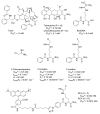Protein arginine deiminase 4 (PAD4): Current understanding and future therapeutic potential
- PMID: 19736621
- PMCID: PMC3771078
Protein arginine deiminase 4 (PAD4): Current understanding and future therapeutic potential
Abstract
The protein arginine deiminases (PADs), and in particular PAD4, have emerged as potential therapeutic targets for the treatment of rheumatoid arthritis (RA). In this review, evidence linking dysregulated PAD activity to the onset and progression of RA is presented, and the potential role of such aberrant activity in other human diseases, such as multiple sclerosis and cancer, is discussed. The known physiological roles of the PADs, particularly PAD4, and current knowledge regarding PAD structure, catalysis and inhibition are also described.
Figures






Similar articles
-
Discovery of a new class of inhibitors for the protein arginine deiminase type 4 (PAD4) by structure-based virtual screening.BMC Bioinformatics. 2012;13 Suppl 17(Suppl 17):S4. doi: 10.1186/1471-2105-13-S17-S4. Epub 2012 Dec 13. BMC Bioinformatics. 2012. PMID: 23282142 Free PMC article.
-
Substrate specificity and kinetic studies of PADs 1, 3, and 4 identify potent and selective inhibitors of protein arginine deiminase 3.Biochemistry. 2010 Jun 15;49(23):4852-63. doi: 10.1021/bi100363t. Biochemistry. 2010. PMID: 20469888 Free PMC article.
-
Revamped role for approved drug: integrative computational and biophysical analysis of saquinavir's peptidyl arginine deiminase 4 inhibition for rheumatoid arthritis.Biochem J. 2024 Oct 16;481(20):1379-1393. doi: 10.1042/BCJ20240366. Biochem J. 2024. PMID: 39312210
-
PAD4: pathophysiology, current therapeutics and future perspective in rheumatoid arthritis.Expert Opin Ther Targets. 2017 Apr;21(4):433-447. doi: 10.1080/14728222.2017.1294160. Epub 2017 Feb 22. Expert Opin Ther Targets. 2017. PMID: 28281906 Review.
-
PAD enzymes in rheumatoid arthritis: pathogenic effectors and autoimmune targets.Nat Rev Rheumatol. 2020 Jun;16(6):301-315. doi: 10.1038/s41584-020-0409-1. Epub 2020 Apr 27. Nat Rev Rheumatol. 2020. PMID: 32341463 Review.
Cited by
-
The induction of microRNA-16 in colon cancer cells by protein arginine deiminase inhibition causes a p53-dependent cell cycle arrest.PLoS One. 2013;8(1):e53791. doi: 10.1371/journal.pone.0053791. Epub 2013 Jan 7. PLoS One. 2013. PMID: 23308284 Free PMC article.
-
NETs are a source of citrullinated autoantigens and stimulate inflammatory responses in rheumatoid arthritis.Sci Transl Med. 2013 Mar 27;5(178):178ra40. doi: 10.1126/scitranslmed.3005580. Sci Transl Med. 2013. PMID: 23536012 Free PMC article.
-
Neutrophil extracellular traps in systemic autoimmune and autoinflammatory diseases.Nat Rev Immunol. 2023 May;23(5):274-288. doi: 10.1038/s41577-022-00787-0. Epub 2022 Oct 18. Nat Rev Immunol. 2023. PMID: 36257987 Free PMC article. Review.
-
The oncolytic bacteria-mediated delivery system of CCDC25 nucleic acid drug inhibits neutrophil extracellular traps induced tumor metastasis.J Nanobiotechnology. 2024 Feb 19;22(1):69. doi: 10.1186/s12951-024-02335-5. J Nanobiotechnology. 2024. PMID: 38369519 Free PMC article.
-
Citrullination as a plausible link to periodontitis, rheumatoid arthritis, atherosclerosis and Alzheimer's disease.J Oral Microbiol. 2018 Jun 22;10(1):1487742. doi: 10.1080/20002297.2018.1487742. eCollection 2018. J Oral Microbiol. 2018. PMID: 29963294 Free PMC article. Review.
References
-
- Rogers GE, Simmonds DH. Content of citrulline and other amino-acids in a protein of hair follicles. Nature. 1958;182(4629):186–187. - PubMed
-
-
Schellekens GA, de Jong BA, van den Hoogen FH, van de Putte LB, van Venrooij WJ. Citrulline is an essential constituent of antigenic determinants recognized by rheumatoid arthritis-specific autoantibodies. J Clin Invest. 1998;101(1):273–281. This report described, for the first time, that RA associated autoantibodies recognize the citrullinated proteins.
-
-
-
Vossenaar ER, Zendman AJ, van Venrooij WJ, Pruijn GJ. PAD, a growing family of citrullinating enzymes: genes, features and involvement in disease. Bioessays. 2003;25(11):1106–1118. An excellent review of the PAD family of enzymes.
-
-
-
Cuthbert GL, Daujat S, Snowden AW, Erdjument-Bromage H, Hagiwara T, Yamada M, Schneider R, Gregory PD, Tempst P, Bannister AJ, Kouzarides T. Histone deimination antagonizes arginine methylation. Cell. 2004;118(5):545–553. This paper and ref. 5 provided the first evidence that PAD4 regulates gene transcription.
-
-
-
Wang Y, Wysocka J, Sayegh J, Lee YH, Perlin JR, Leonelli L, Sonbuchner LS, McDonald CH, Cook RG, Dou Y, Roeder RG, et al. Human PAD4 Regulates Histone Arginine Methylation Levels via Demethylimination. Science. 2004;306:279–283. This paper and ref. 4 provided the first evidence that PAD4 regulates gene transcription.
-
Publication types
MeSH terms
Substances
Grants and funding
LinkOut - more resources
Full Text Sources
Other Literature Sources
